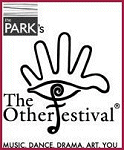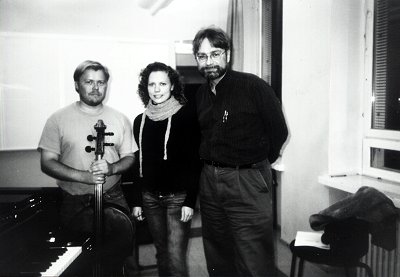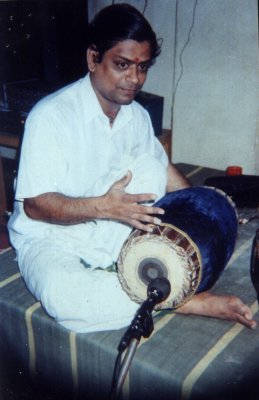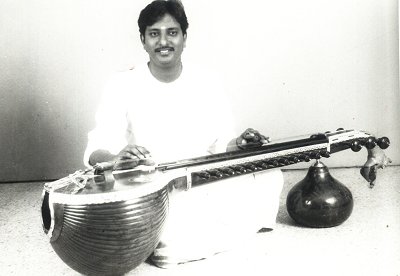| The Park’s
The Other Festival - 2004
Music. Dance. Drama. Art. You. The Chinmaya
Heritage Centre, Chennai
|
 |
EERO
HAMEENNIEMI (Finland) + INDIAN COLLABORATION – Music - Premiere Show (40
mins)
 |
 |
 |
| Pensola
and Ruottinen are experts on the art of Western Classical The premiere
composition by Eero will be played by two very well known Finnish virtuoso
musicians, Minna Pensola, violin, and Roi Ruottinen, cello, with Eero on
the harmonium. The Indian representation will be by A. Durgaprasad and
R Ramesh.
Eero Hämeenniemi, has collaborated with a number of Indian artists in the past, including: Karaikudi R. Mani, K.S. Subramanian, Daksha Sheth, Mahesh Dattani, Shobana Jeyasingh and Mallika Sarabhai. eRRe is an ensemble joining together Carnatic and Western musicians. ”Mylapore Variations” explores the ways different variation techniques are used in the two traditions. This includes both predetermined (theme and variations, sangatis) and improvised variations. R Ramesh (mridangist) has trained under maestro Sri Karaikudi R Mani and won several awards for his expertise in percussion with the mridangam. He has accompanied leading Carnatic musicians including Padmasri Lalgudi Jayaraman, Shri Maharajapuram Santhanam and Sri T N Seshagopalan, among others. He has travelled widely on concert tours. He is currently with All India Radio, Chennai. Durga Prasad (gottuvadyam) has trained under his father, gottuvadyam vidwan Sri Allam Koteswara Rao as well as under late Guru Kalasikhamani Sri A Narayana Iyer. According to ancient classification of stringed instruments, gottuvadyam is classified under the veena group of musical instruments.While the veena is fretted, the gottuvadyam is unfretted. An orthodox musician with a rare rhythmic balance and tonal purity in his performances, Durga Prasad has performed around the globe at various music festivals and won appreciation from listeners and critics alike. He is currently with All India Radio, Chennai. The Park’s
THE OTHER FESTIVAL is proud to bring the world premiere of “Mylapore
Variations”.
|
| Exclusive
interview with Eero Hämeenniemi
by Lalitha Venkat Your work
has grown through the stages of ‘Modernist to Neo- Expressionist in the
1980s to tradition conscious’ (according to a write-up on the net). How
did you evolve through these styles?
You have
composed for symphonies, jazz, ballets, dance and even chamber music. How
do you approach these varied music genres?
For jazz and chamber music, the main consideration is the role of the individual musician, as these are forms, where interaction between the players is very important. Music for dance tends to emphasize the element of rhythm, as dancers need something to hang on to. Since 1990s,
the blending of Indian elements has become an integral and inseparable
part of your music. What interested you in Indian rhythms?
You are
one of the first Finnish composers to take a serious interest in dance,
western as well as Indian. Has your frequent visits to India prompted this
interest?
Much of
the fusion music available sounds so repetitive, and is even being marketed
as “lounge music”. Your comment.
Is your
appearance at The Park’s THE OTHER FESTIVAL, your first performance in
India? How do you feel about it?
Was “Mylapore
Variations” specially composed for The Other Festival? A few words on the
world premiere of this work.
Contact:
|